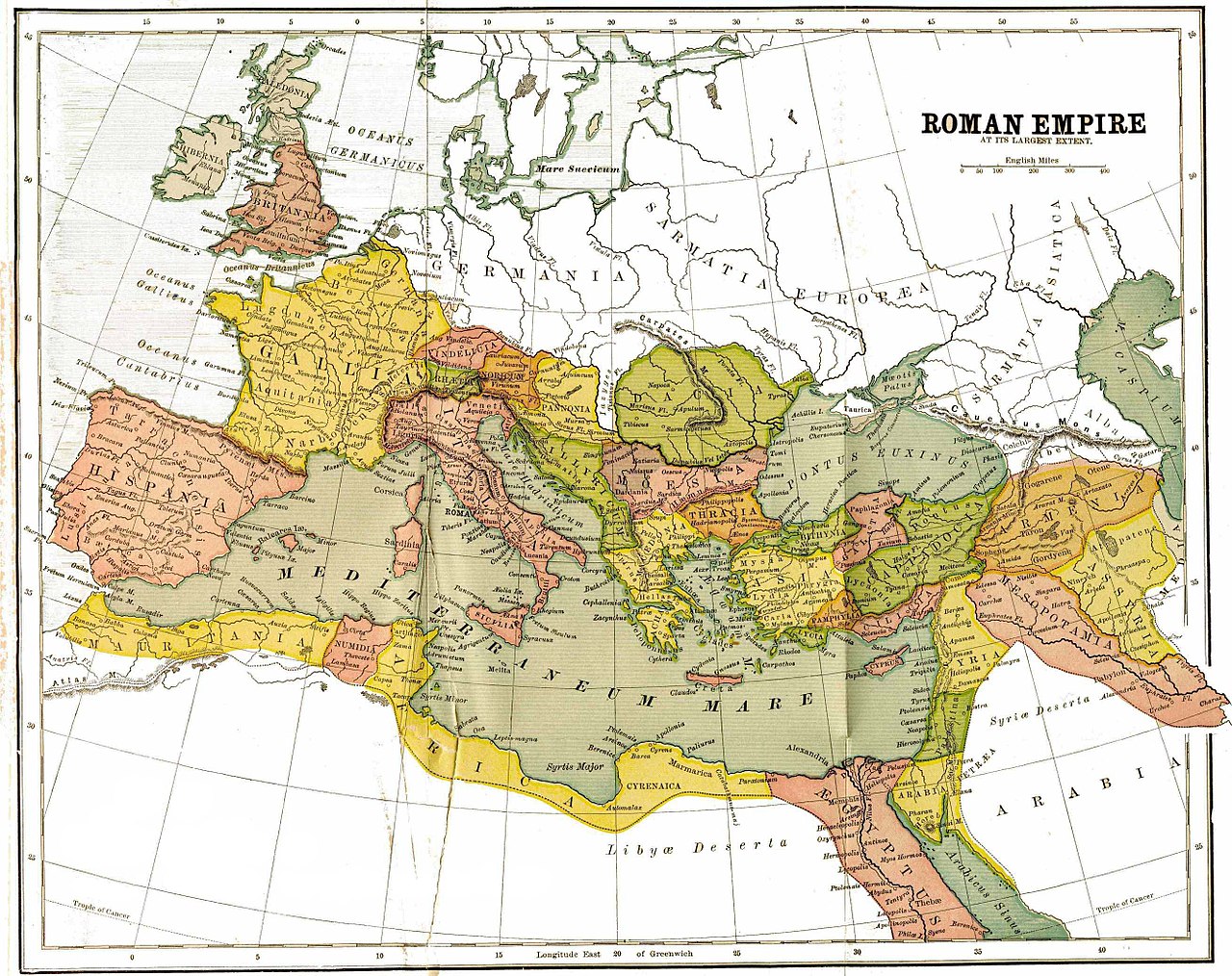Four languages were commonly used in ancient Palestine. Which would Jesus have spoken?
◊
Who was Jesus? The answer is at once obvious and obscure. As the central figure of one of the world’s major religions, Jesus has been depicted countless times in art, music, film, and more. But what do we really know about Jesus of Nazareth, the man who lived 2,000 years ago? What did his daily life really look like, what did he eat – and what language did he speak?
Although so much about his life and works is shrouded in the conflict between historical accounts and religious faith, there are some points that scholars and religious leaders agree on. Jesus was very likely born between 6 and 4 BCE, and died around 30 CE. He was from the village of Nazareth in the Galilee region, which is in modern-day northern Israel. At the time Jesus lived, this region was under the rule of the Roman Empire.
Four languages were widely used in Roman Palestine: Latin, Greek, Hebrew, and Aramaic. There is near-consensus among scholars that Jesus spoke the ancient language Aramaic in his everyday life. And while scholarship and common sense also suggest that he was likely multilingual, there is disagreement about which other languages he spoke – and even whether or not he was actually literate.
For more on Jesus of Nazareth and the origins of Christianity, check out the MagellanTV documentary The Bible: A History.
Literacy and Languages in Roman Palestine
In fact, most people were illiterate in the ancient Middle East. Historians estimate that the general literacy rate was somewhere between three and ten percent, with the ability to read and write being limited mostly to the religious elite and the wealthy upper class. Would the son of a carpenter have been taught to read and write? Or might he have acquired literacy at a later stage of his early life? There is no consensus answer to these questions among scholars, but we know that Jesus did engage effectively in several documented debates with highly educated Pharisees.
We also know that Jesus left Nazareth to spend much of his life traveling throughout Roman Palestine. Just as international businesspeople today usually have a cursory knowledge of the languages used in the countries where they travel, someone like Jesus traveling among the diverse populations of the Middle East in the first century CE would probably have needed to speak more than just his native tongue.

Crowd reacts with both fear and adoration to Jesus arriving in a village on a donkey. (Credit: Anonymous, c. 1890, via Library of Congress)
Under Roman rule, language was not just a means of communication – it also delineated one’s position in society. For example, Roman government officials would often have spoken and written in Greek. And, as the lingua franca of the empire, Greek would also have been essential in trade and transport. Military officers, on the other hand, would have favored Latin, and Jewish religious leaders would have relied on Hebrew.
As a religious leader himself, Jesus would have had to be able to communicate with people from all walks of life. He is famously recorded in the New Testament as having spoken with peasants, prostitutes, and prominent religious and governmental leaders alike. In order to communicate with such diverse groups of people, it stands to reason that Jesus would have had at least some knowledge of several languages. In addition to Aramaic, Hebrew would have been useful in discussions with religious leaders and recitation of many religious texts. Latin, and especially Greek, would have helped him communicate with government officials, as the Bible maintains that he did. But when would Jesus have used these languages, how well did he know them, and what is the evidence that he used each of them?

“Life of Mary,” written in Aramaic by Patriarch Theophilus of Alexandria and Jacob of Serugh, c. 5th century; transcribed by Slibona, c. 1567-1568. (Source: World Digital Library, via Library of Congress)
Aramaic
Scholars generally believe that Aramaic was Jesus’s native tongue. It is a semitic language closely related to Hebrew, introduced by the Aramaeans in the 11th century BCE. Even after the Aramaeans were conquered, their language endured, used by several successive Middle Eastern empires as a common language to unify the diverse populations living within them. (It is still spoken in some small towns and villages in Syria.) Before Jesus’s time, Alexander the Great had already made great progress in spreading Koine Greek and Hellenistic culture throughout the Middle East, but Aramaic remained the common tongue in many parts of the Middle East.
This was especially true in Syria and Palestine. At the time that Jesus lived, Aramaic would have been the language used in everyday settings in these regions. Jesus would likely have used his native tongue to speak with his disciples, as well as the common people he met and taught in his travels through Galilee and Judea.

Palestine in the time of Jesus (Credit: George Philip & Son, Cartographer, and London Geographical Institute, 1916, via Library of Congress, Geography and Map Division)
How have scholars determined that Jesus likely spoke Aramaic as his first language? First, many historians base this deduction on a rich written record of Palestinian documents in Aramaic from around the time Jesus lived. These documents establish that Aramaic was widely used. And, in addition, scholars often point to portions of the Old Testament that were originally written in Aramaic, as well as parts of the Talmud. But there is much less agreement about the other languages Jesus may have been familiar with.

(Credit: Natalia Y. via Unsplash)
Hebrew
As the language of most Judaic religious texts and of the Jewish elites, Hebrew almost certainly would have been used by Jesus in certain situations. But how much Hebrew did he know? This question was famously the subject of a brief disagreement between Prime Minister Benjamin Netanyahu of Israel and Pope Francis in 2014:
“Jesus was here, in this land. He spoke Hebrew,” Netanyahu told the Pope. “Aramaic,” the Pope cut in. “He spoke Aramaic, but he knew Hebrew.”
As the Pope points out, Jesus must have known enough Hebrew to engage with Jewish religious leaders and, perhaps, to read texts that were written in the language. However, he likely wasn’t using Hebrew regularly. As put by John Poirer,
“. . . there were indeed contexts in which Hebrew continued to be spoken, but these were localized, either geographically (i.e., in the hills of Judea), professionally (i.e., among priests and sages), or along sectarian lines (i.e., among the Qumranites).”
Taken altogether, the evidence paints a picture of Jesus using Hebrew occasionally, as a helpful secondary language.

The Roman Empire in 150 CE (Credit: George R. Crooks, 1897, via Wikimedia Commons)
Greek & Latin
The importance of Alexander the Great in the spread of the Greek language and Hellenistic culture throughout Mediterranean and Middle Eastern regions can hardly be overstated. As a student of Aristotle, he was a passionate advocate for the universality of Greek thought, and extending its reach into the territories he conquered was a central goal. His death, in 323 BCE, didn’t slow the growth of Greek ideas and ideals; indeed, the Hellenistic period extended from the time of Alexander’s demise until Cleopatra’s death in 30 BCE. Eventually, Greek superseded Aramaic as an everyday language for many people. And, it remained the language of elites, including the political class and wealthy tradesmen through the time of Jesus and beyond.
Jesus would have needed to know at least basic Greek in his interactions with government officials. And, as the son of a carpenter, he would have found it handy in performing his job as he traveled the Judean region (possibly even to nearby, Greek-speaking Tiberias). However, it is still unclear how common Greek was in everyday conversation at the time.

Christ before Pilate, Mihály Munkácsy, 1881 (Source: Wikimedia Commons)
While some evidence is thin or speculative, there are facts pointing to the possibility that Jesus knew Greek quite well: the language was used almost exclusively in trade, and Nazareth, the town of Jesus’ birth, and the region where his carpenter father would have worked, overlooked the Via Maris, a busy trade route in ancient Palestine. Several of Jesus’s disciples had Greek names, and one was a former tax collector and would have certainly known Greek for his work.
And, of course, there is the New Testament account of Jesus’s trial, overseen by Pontius Pilate. It is probable that their conversation would have taken place in Greek, as Stanley E. Porter, president of McMaster Divinity College argues:
“It is highly unlikely that Pilate, the prefect assigned to this remote posting in the Roman empire, would have known any Semitic language. No translator or interpreter is mentioned for the conversation that occurs between Jesus and Pilate, making it unlikely that Latin or Aramaic was used. In fact, the pace of the narrative, in which conversation is held between not only Pilate and Jesus but Pilate and the Jewish leaders, Pilate and the crowd, and the Jewish leaders and the crowd, argues against an interpreter intervening. It is most likely, therefore, that Jesus spoke to Pilate in Greek.”
Of the four common languages in Roman Palestine, perhaps it is least likely that Jesus would have had much, if any, fluency in Latin. At the time Jesus was alive, the Roman Empire was in linguistic flux. The golden age of the Greek language and writing had recently passed, and Greek was still typically used by government officials and the upper class. But, as the Roman Empire expanded, Latin, too, rose in prominence.
Although most Roman officials would have spoken both Greek and Latin, scholars tend to agree it is more likely that Jesus would have used Greek, not Latin, to communicate with such officials. Greek continued to be the popular lingua franca of the empire, while Latin was more specialized in its use for legal and military purposes. It was likely not a language the son of a carpenter, even a prominent and learned one, would have known well.
Want to Learn More About Who Jesus Was?
The languages Jesus would have known tell us something about the complex figure he was. At once born the lower-class son of a carpenter and likely multilingual, he existed outside of usual categorizations of “upper” and “lower” class. Want to expand your knowledge about the historical Jesus of Nazareth? Watch the “Who Was Jesus?” episode of MagellanTV’s The Bible: A History for more.
Ω
Sari Wagner is a contributing writer for MagellanTV. Originally from Philadelphia, she is a graduate of Kenyon College with a degree in neuroscience and studio art. She is passionate about making complicated information accessible and artful.
Title Image: The Last Supper. Leonardo Da Vinci, 1498. Santa Maria delle Grazie.

